Expressive Circles—Original Concept Regarding the Structural and Dramaturgical Aspects of the Musical Composition in the Piece EXPRESSIVE CIRCLES—Three Pieces for Piano Trio: Composer’s Self-Reflection
Abstract
1. Introduction—Between the Content and the Form of the Artistic Work
2. Compositional Principles—Fundamental Ideas Behind Expressive Circles
2.1. Philosophical and Aesthetical Background
2.2. Musical Background of Expressive Circles
3. Expressive Circles
3.1. Definition
3.2. Basic Principles of Expressive Circles
3.3. Narration and Dramaturgy in Expressive Circles
4. Three Types of Expressive Circles
4.1. Closed Structure
4.1.1. Premise of the Closed Structure
4.1.2. Representation of the Closed Structure in the Piece Continuum
4.1.3. Architectonics and Dramaturgy of Continuum—Overall Development of the Closed Structure
4.2. Open Structure
4.2.1. Premise of the Open Structure
4.2.2. Representation of the Open Structure in the Piece FORWARD
4.2.3. Architectonics and Dramaturgy of FORWARD—Overall Development of the Open Structure
4.3. Inverted Structure
4.3.1. Premise of the Inverted Structure
4.3.2. Representation of the Inverted Structure in the Piece Drive 303
4.3.3. Architectonics and Dramaturgy of Drive 303—Overall Development of the Inverted Structure
5. Summary
Funding
Data Availability Statement
Conflicts of Interest
References
- Adorno, Theodor, Elisabeth Lenk, and Susan H. Gillespie. 2015. The Challenge of Surrealism: The Correspondence of Theodor W. Adorno and Elisabeth Lenk. Edited and Translated by Susan H. Gillespie. Minneapolis: University of Minesota Press. [Google Scholar]
- Arsenault, Linda Marie. 2000. An Introduction to Iannis Xenakis’s Stochastic Music: Four Algorithmic Analyses. Doctoral thesis, University of Toronto, Toronto, ON, Canada. [Google Scholar]
- Blume, Friedrich. 1970. Classic and Romantic Music; a Comprehensive Survey. Edited by Friedrich Blume. New York: W. W. Norton & Company, pp. 8–37. [Google Scholar]
- Breton, Andre. 1969. Manifestoes of Surrealism. Michigan: University of Michigan Press. [Google Scholar]
- Calkins, Susan. 2010. Modernism in Music and Erik Satie’s Parade. International Review of the Aesthetics and Sociology of Music 41: 3–19. [Google Scholar]
- Cecchi, Alessandro. 2016. Formal Tension in Energetics and Beyond. In Nuove Musiche: 1. Pisa: Pisa University Press, pp. 71–83. [Google Scholar]
- Chomiński, Józef, and Krystyna Wilkowska-Chomińska. 1983. Formy Muzyczne. Kraków: Polskie Wydawnictwo Muzyczne, vol. 1, p. 23. [Google Scholar]
- Dempsey, Amy. 2019. Surrealism. Edited by Caroline Brooke Johnson. London: Thames & Hudson Ltd. [Google Scholar]
- Dissanayake, Ellen. 1988. What is Art. In What Is Art for. Seattle: University of Washington Press, pp. 34–39. [Google Scholar]
- Fink, Robert. 2005. Repeating Ourselves: American Minimal Music as Cultural Practice. Berkley: University of California Press. [Google Scholar]
- Frankl, Viktor. 1966. Self-Transcendence as a Human Phenomenon. Journal of Humanistic Psychology 6: 97–106. [Google Scholar] [CrossRef]
- Gardner, Sebastian. 2002. The Romantic Metaphysical Theory of Art. European Journal of Philosophy 10: 275–301. [Google Scholar] [CrossRef]
- Goehr, Lydia. 1992. The Imaginary Museum of Musical Works: An Essay in the Philosophy of Music. Oxford: Clarendon Press. [Google Scholar]
- Granat-Janki, Anna. 2010. “Surconventionalism” in the Interpretation of Paweł Szymański and Stanisław Krupowicz. In Musicology Today. Edited by Valentina Sandu-Dediu. Bucharest: National University of Music Bucharest, vol. 1. [Google Scholar]
- Granat-Janki, Anna. 2017. Poetyka intertekstualna surkonwencjonalistów. In Aspekty Muzyki. Gdańsk: Akademia Muzyczna im. S. Moniuszki w Gdańsku, vol. 7, pp. 105–18. [Google Scholar]
- Green, Douglass. 1979. Introduction: Form, Shape, and Genere. In Form in Tonal Music: Introduction to Analysis, 2nd ed. New York: Holt, Rinehart and Winston, pp. 1–5. [Google Scholar]
- Hryniewicz, Karol. 2014. Cogito i Dubito. Dyskurs estetyczny w poezji Zbigniewa Herberta i Tadeusza Różewicza. Edited by Józef Maria Ruszar. Kraków: Wydawnictwo JMR Trans-Atlantyk, pp. 287–312. [Google Scholar]
- Hutcheson, Jere T. 1976. Some Basic Concepts Concerning Musical Form. In Musical Form and Analysis. Boston: Allyn & Bacon, vol. 1, pp. 1–18. [Google Scholar]
- Isac, Iuliana. 2021. Repetitive Minimalism in the Work of Philip Glass. Composition Techniques. Bulletin of the Transilvania University of Brasov. Series VIII: Performing Arts 13: 141–48. [Google Scholar] [CrossRef]
- Janicka, Krystyna. 1985. Elementy surrealistycznego światopoglądu. In Surrealizm. Edited by Anna Gogut. Warszawa: Wydawnictwo Artystyczne i Filmowe, pp. 29–56. [Google Scholar]
- Jarzębska, Alicja. 2004. Spór o piękno muzyki. Wprowadzenie do kultury muzycznej XX i XXI wieku. Edited by Grażyna Plater. Wrocław: Wydawnictwo Uniwersystetu Wrocławskiego. [Google Scholar]
- Jasiński, Tomasz. 2014. Krótki wykład o muzyce XX wieku. Kompendium dydaktyczne. In Annales Universitatis Mariae Curie-Sklodowska sectio L—Artes. Lublin: Maria Curie-Skłodowska University, vol. 12, pp. 74–75. [Google Scholar]
- Johnson, Timothy A. 1994. Minimalism: Aesthetic, Style, or Technique? The Musical Quarterly 78: 742–43. [Google Scholar] [CrossRef][Green Version]
- Konaszkiewicz, Zofia. 2019. W poszukiwaniu sensu—Wokół logoterapii Viktora Frankla. In Szkoła artystyczna, zeszyt 2(6)/2019. Edited by Beata Lewińska. Warszawa: Centrum Edukacji Artystycznej, pp. 75–94. [Google Scholar]
- Kostka, Violetta. 2017. Wykładnik intertekstualny, interpretant i znaczeniowa gra—Klucze do interpretacji muzyki Pawła Szymańskiego. In Aspekty muzyki. Gdańsk: Akademia Muzyczna im. S. Moniuszki w Gdańsku, vol. 7, pp. 119–40. [Google Scholar][Green Version]
- Kramer, Jonathan. 1981. New Temporalities in Music. Critical Inquiry 7: 539–56. [Google Scholar] [CrossRef]
- Krupowicz, Stanisław. 1994. Surkonwencjonalizm. Vivo 1: 57. [Google Scholar]
- Kulenty, Hanna. 2016. Musique Surrealistique. Composer’s Commentary About Her Technique. Available online: https://www.hannakulenty.com/06.2_texts_technique.html (accessed on 28 May 2025).
- Kulenty-Majoor, Hanna. 2015. Moja Filozofia Muzyki. Post-doctoral degree thesis, Akademia Muzyczna im. Karola Szymanowskiego w Katowicach, Katowice, Poland. [Google Scholar]
- MacPherson, Stewart. 2006. Chapter 1: Introductory. In Form in Music. Pomona: Pomona Press, pp. 18–26. [Google Scholar]
- Mandelbrot, Benoit B. 1989. Fractal geometry: What is it, and what does it do? Proceedings of the Royal Society of London. A. Mathematical and Physical Sciences 423: 3–16. [Google Scholar]
- Mertens, Wim. 1988. Basics Concepts of Minimal Music. In American Minimal Music: La Monte Young, Terry Riley, Steve Reich, Philip Glass. London: Kahn & Averill, pp. 87–95. [Google Scholar]
- Mishra, Raj Kiran. 2011. A study of form and content. International Journal of English and Literature 2: 157–60. [Google Scholar]
- Mokrzewski, Dominik, Jan Topolski, Magda Wołczek, and Sławek Wieczorek. 2005. Między komponowaniem krytycznym a surkonwencjonalizmem: Dyskusja. In Glissando. Edited by Jan Topolski. Warszawa: Fundacja Pro Musica Viva, vol. 4, pp. 33–34. [Google Scholar]
- Paddison, Max. 2010. Mimesis and the Aesthetics of Musical Expression. Music Analysis 29: 126–48. [Google Scholar] [CrossRef]
- Pociej, Bohdan. 2008. Romantyzm bez granic. Warszawa: Wydawnictwo WIĘZI, p. 25. [Google Scholar]
- Rocconi, Eleonora. 2012. The Aesthetic Value of Music in Platonic Thought. In Aesthetic Value in Classical Antiquity. Edited by Ineke Sluiter and Ralph M. Rosen. Leiden/Boston: Brill, pp. 113–32. [Google Scholar]
- Siemaszko, Piotr. 2014. Piękno ocalające. Estetyczny i etyczny wymiar twórczości Zbigniewa Herberta. Paper presented at Lecture Given During the Opening of the Exhibition of Paintings by Jan Kaja Titled Lekki powiew, Bydgoszcz, Poland, September 25. Available online: https://autorska.pl/13-archiwum/1639-zycie-w-ukryciu-odslona-20 (accessed on 28 May 2025).
- Stecker, Robert. 2001. Expressiveness and Expression in Music and Poetry. Journal of Aesthetics and Art Criticis 59: 85–89. [Google Scholar] [CrossRef]
- Stein, Leon. 1995. Single-Movement Form. In Structure & Style: The Study and Analysis of Musical Forms. Los Angeles: Summy Birchard Inc., pp. 85–99. [Google Scholar]
- Szerszenowicz, Jacek. 2012. Płaszczyzny „korespondencji” między muzyką i sztukami plastycznymi. In Inspiracje plastyczne w muzyce. Łódź: Akademia Muzyczna w Łodzi. [Google Scholar]
- Szwajgier, Krzysztof. 2015. The Poetics of Unism in Music. Musicology Today 12: 127–36. [Google Scholar] [CrossRef][Green Version]
- Warburton, Dan. 1988. A Working Terminology for Minimal Music. Intégral 2: 135–59. [Google Scholar][Green Version]
- Winnicka, Marlena. 2014. Forma dwuczęściowa w twórczości Witolda Lutosławskiego. Muzyka. Historia. Teoria. Edukacja 4: 57–73. [Google Scholar] [CrossRef]
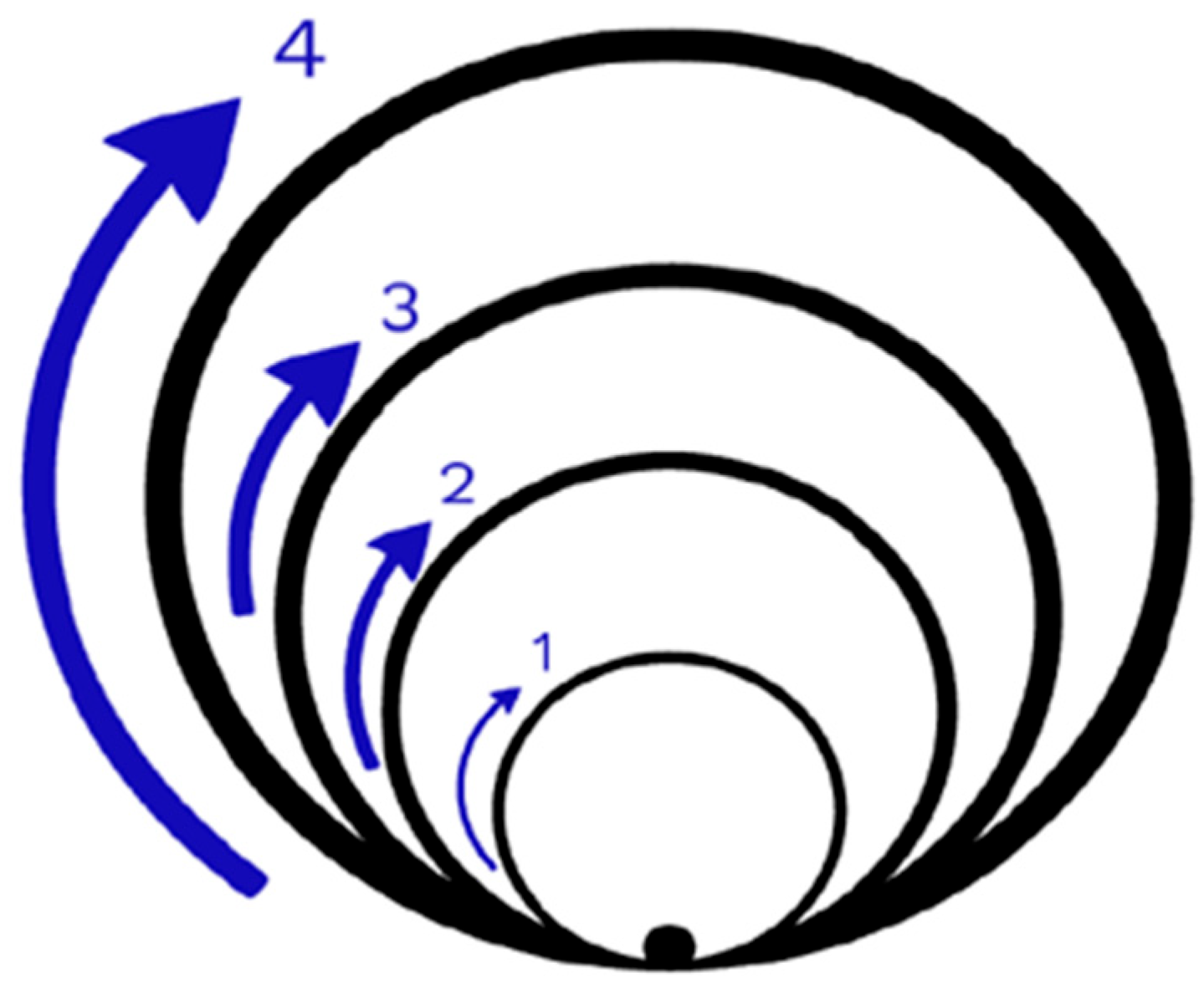
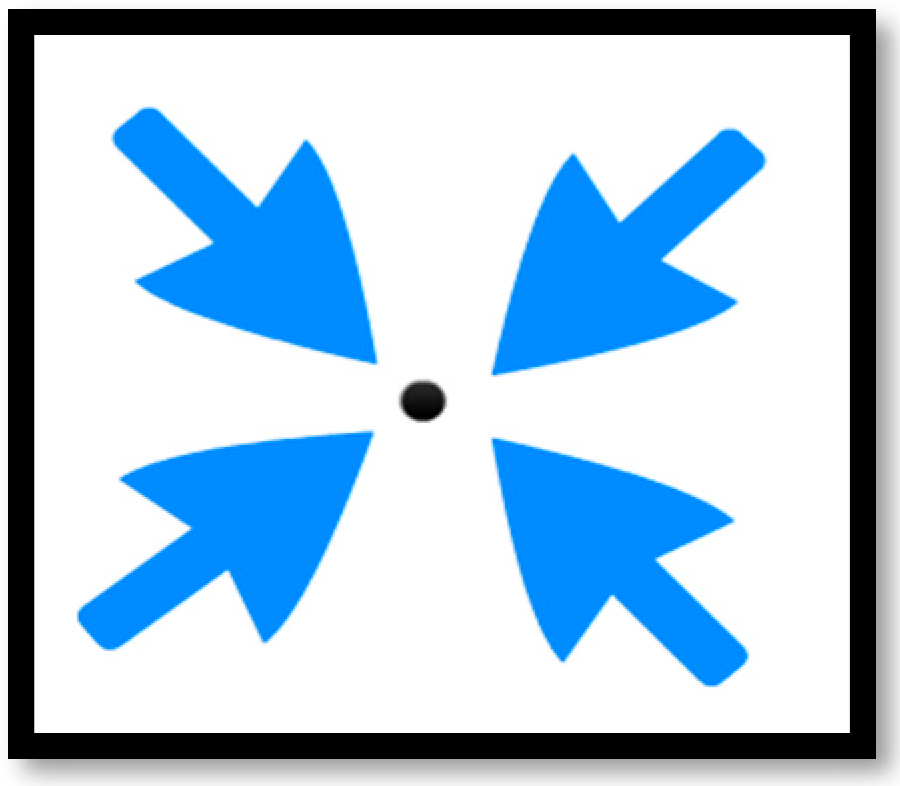
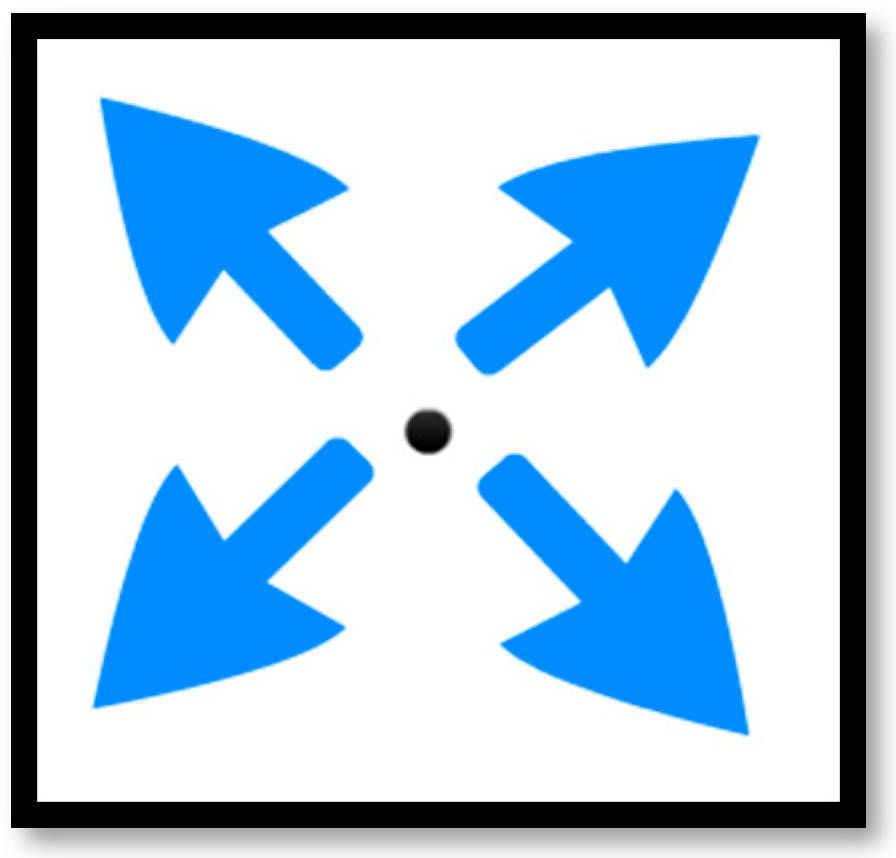
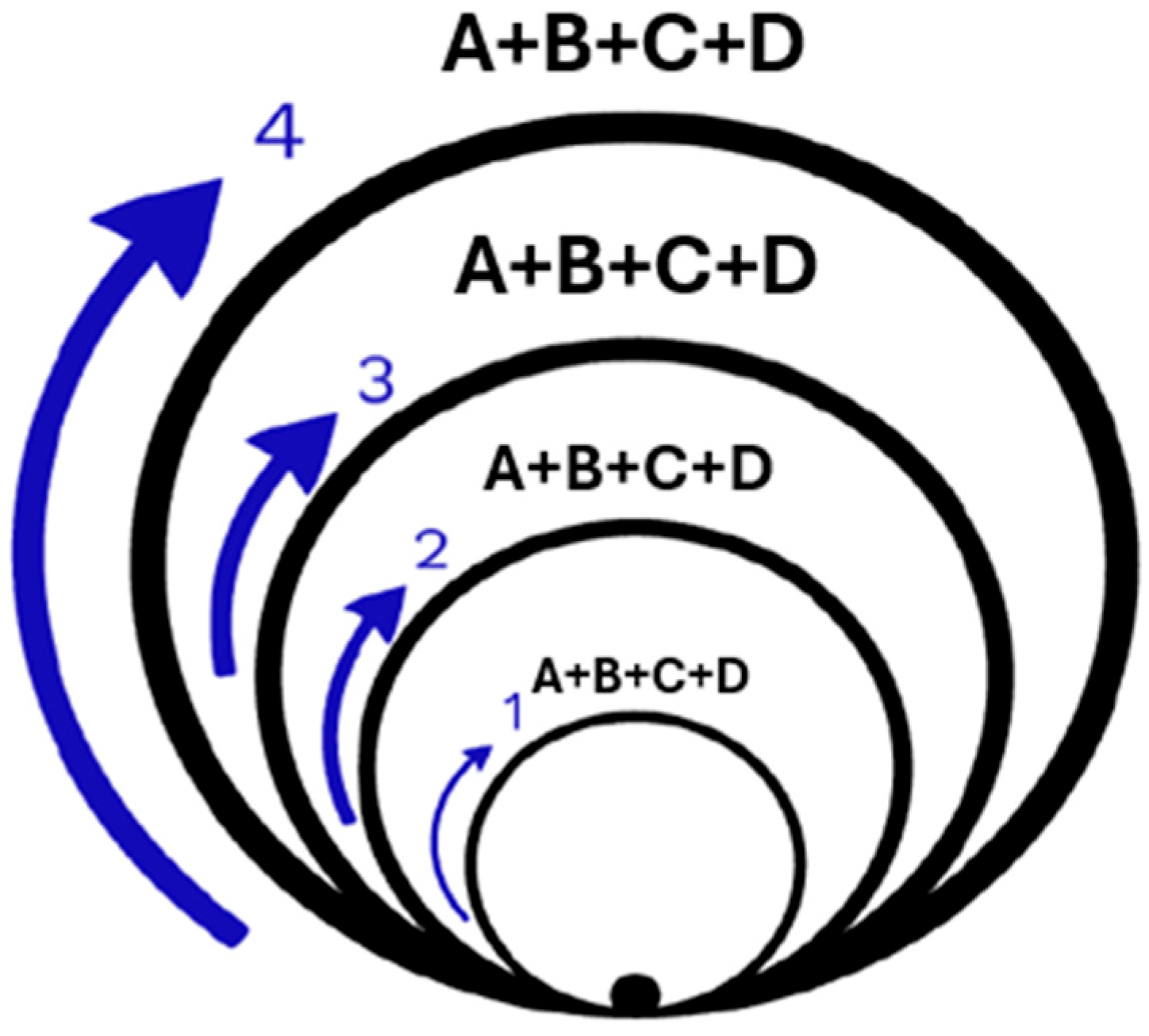

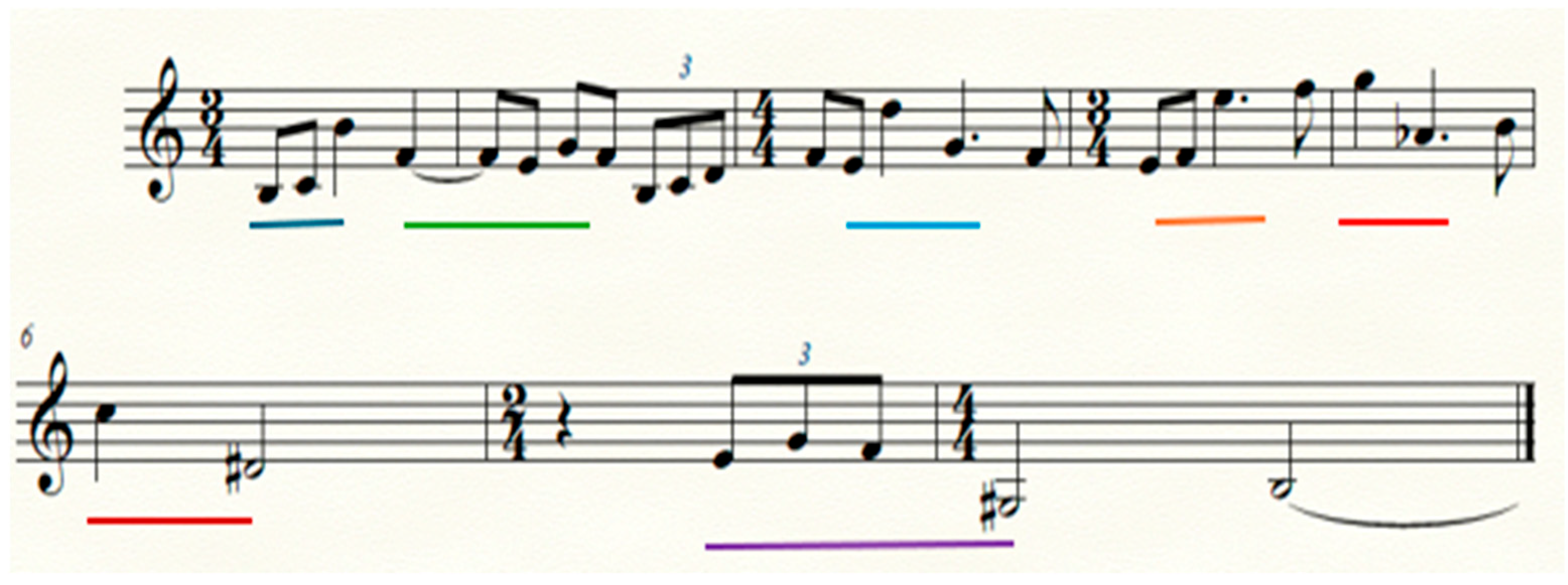
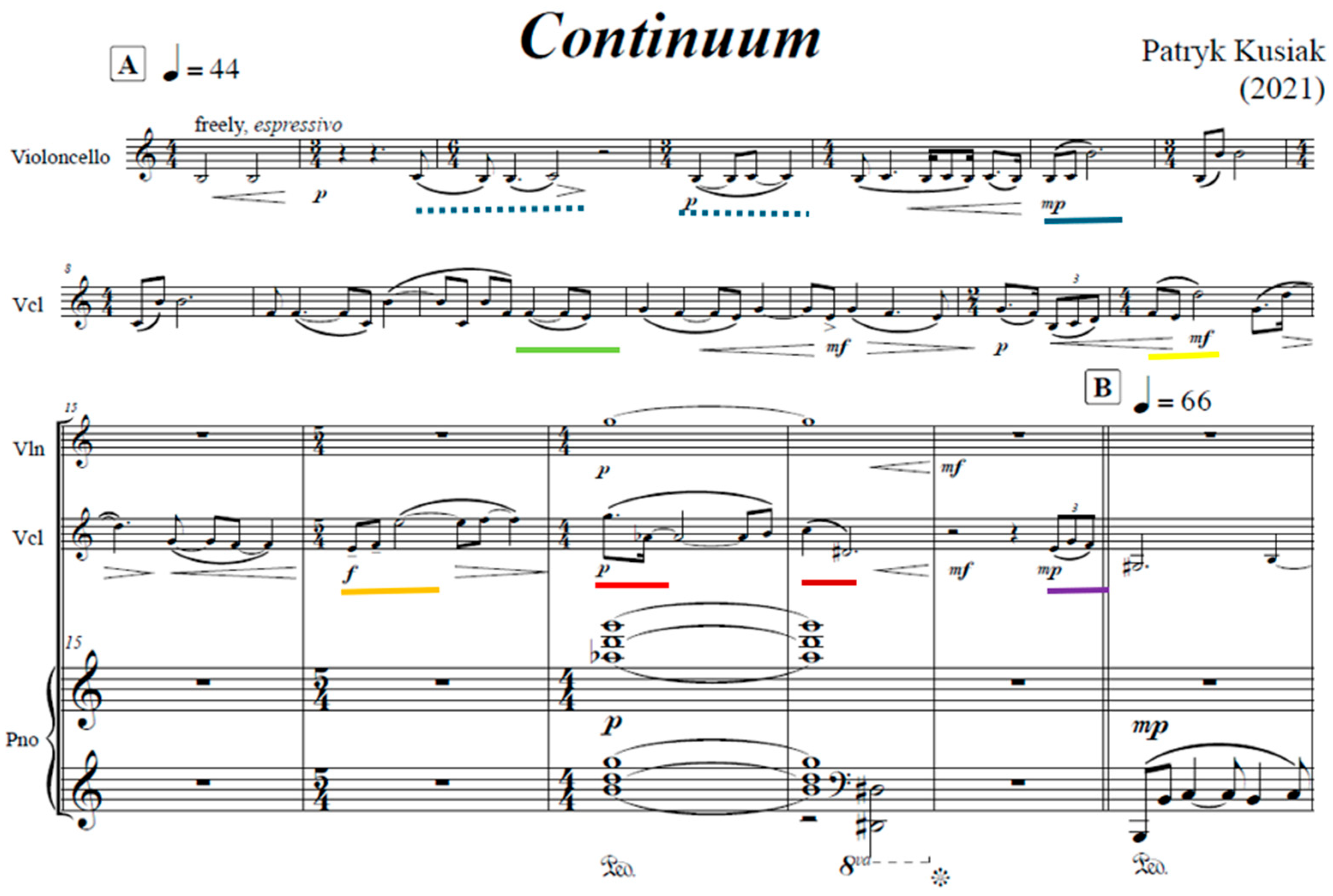
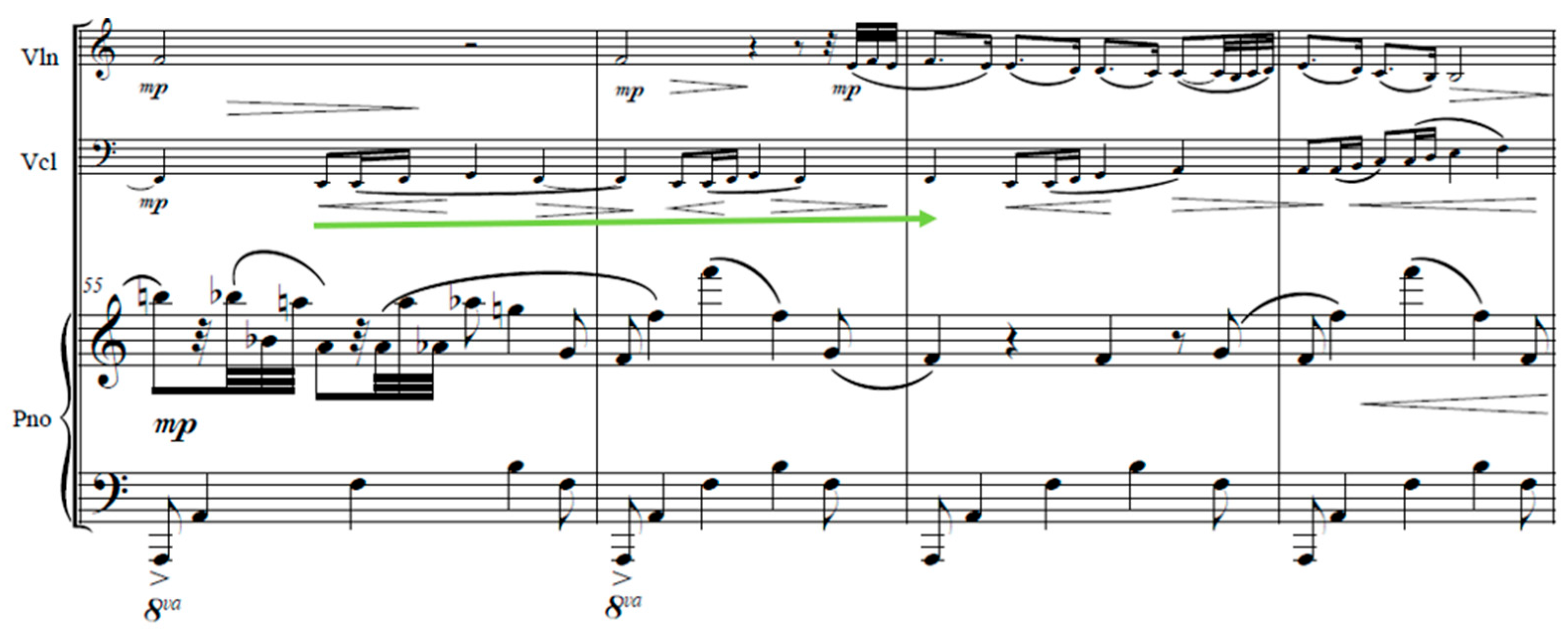
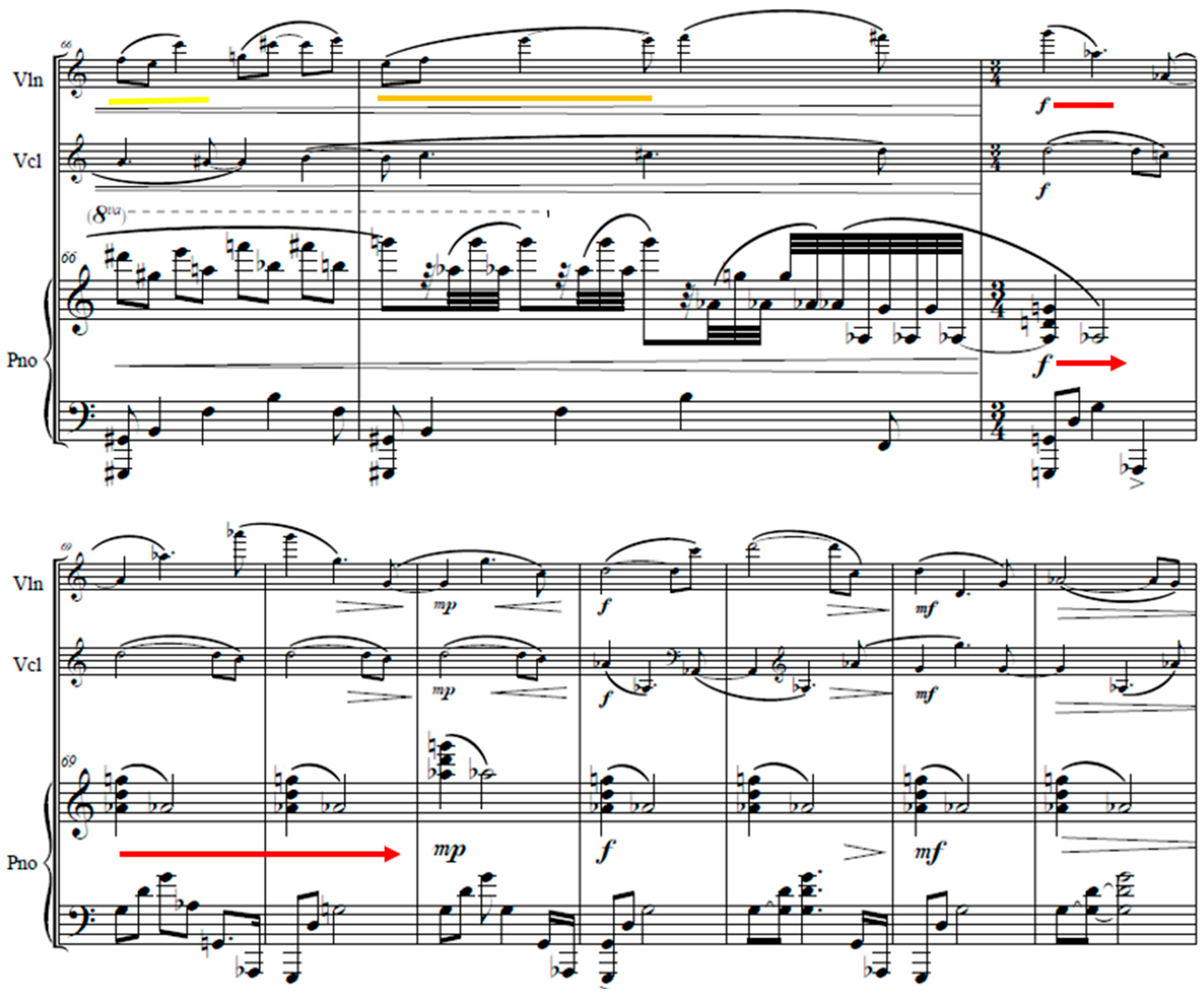
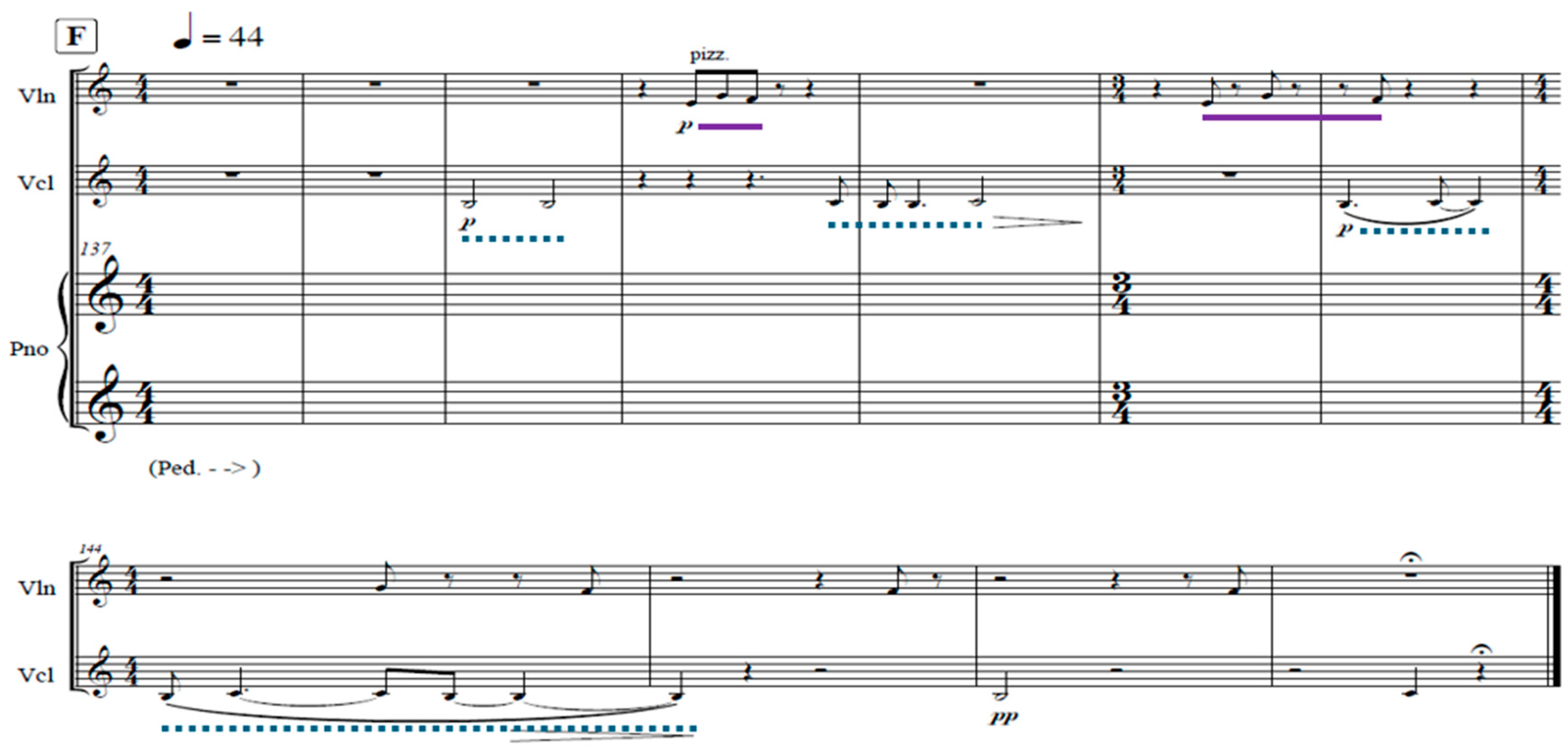





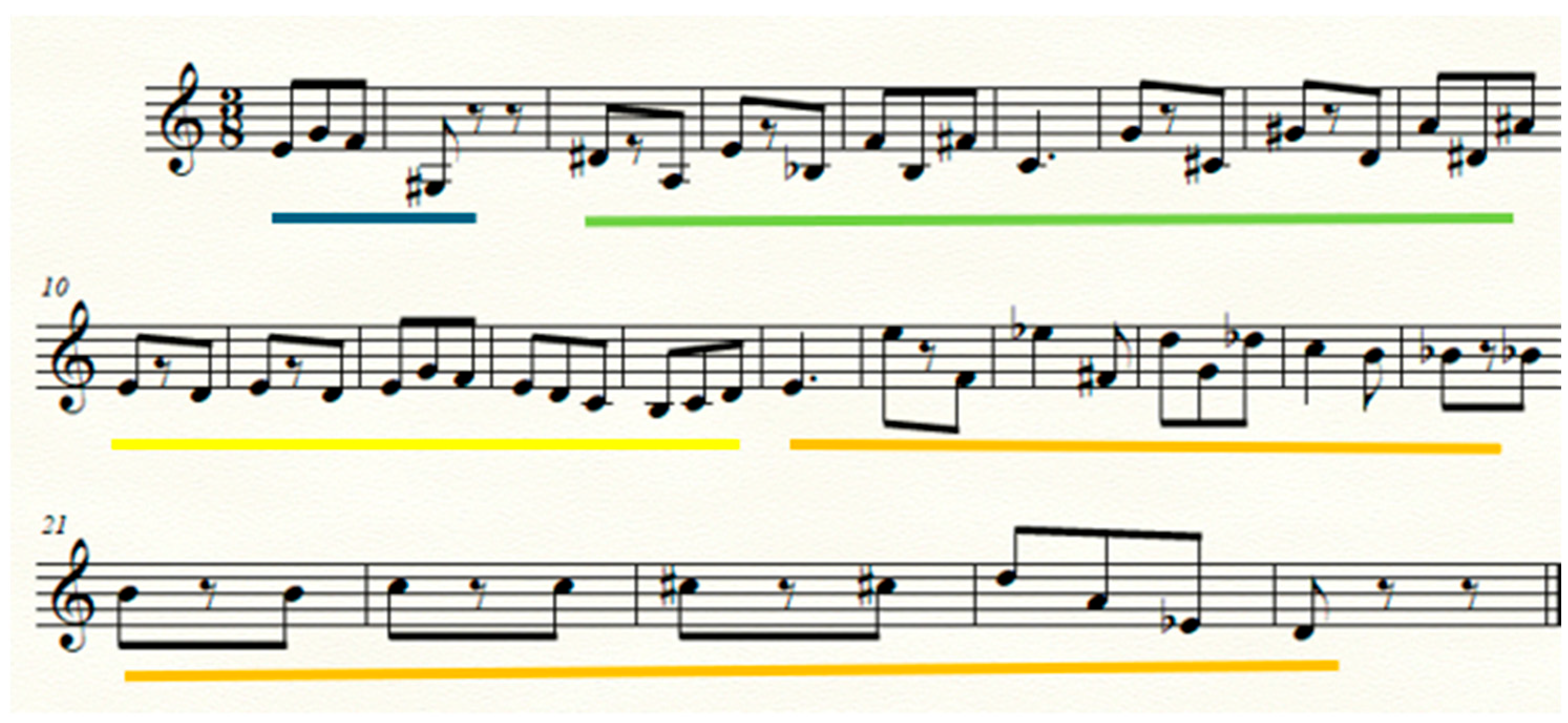

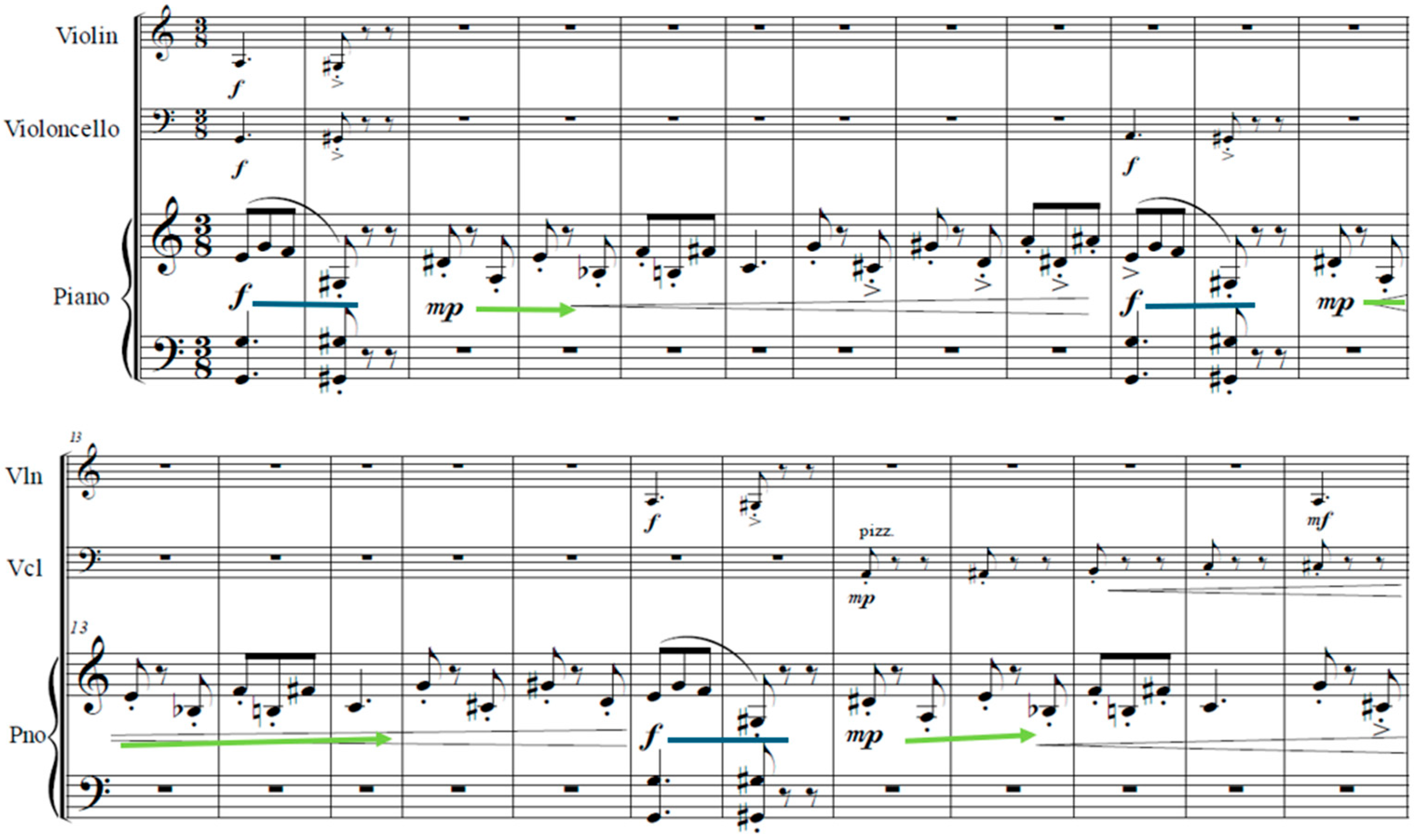
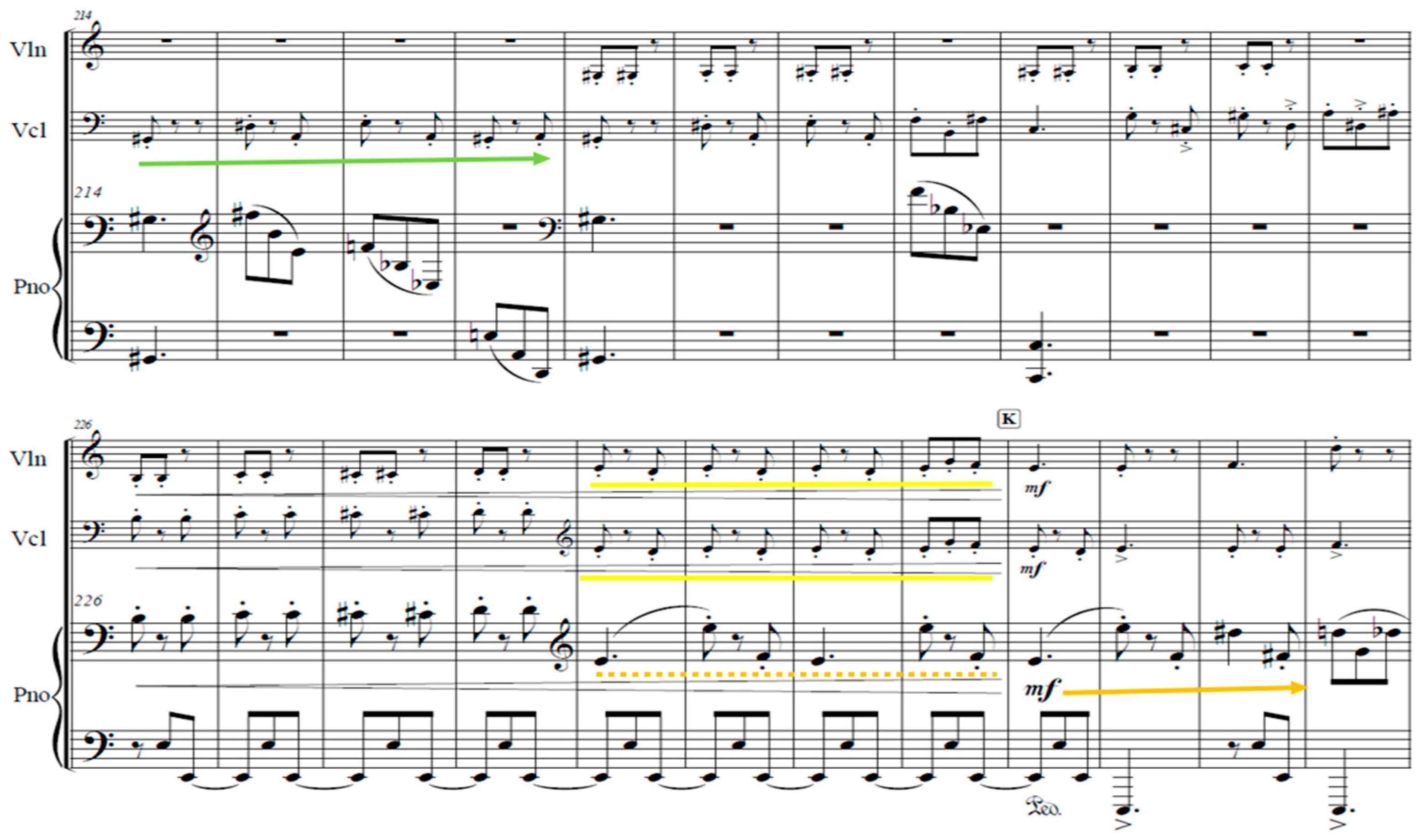

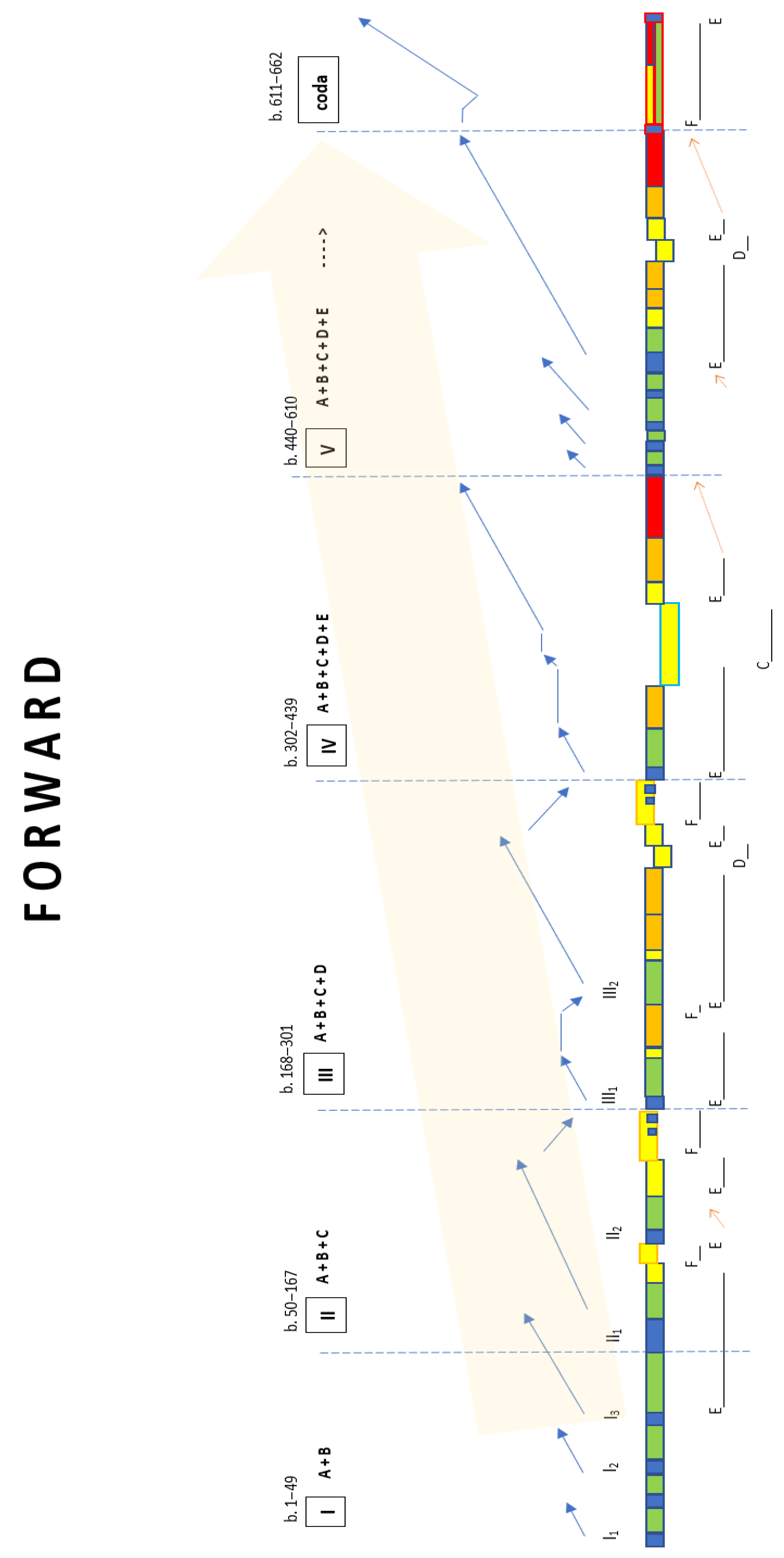
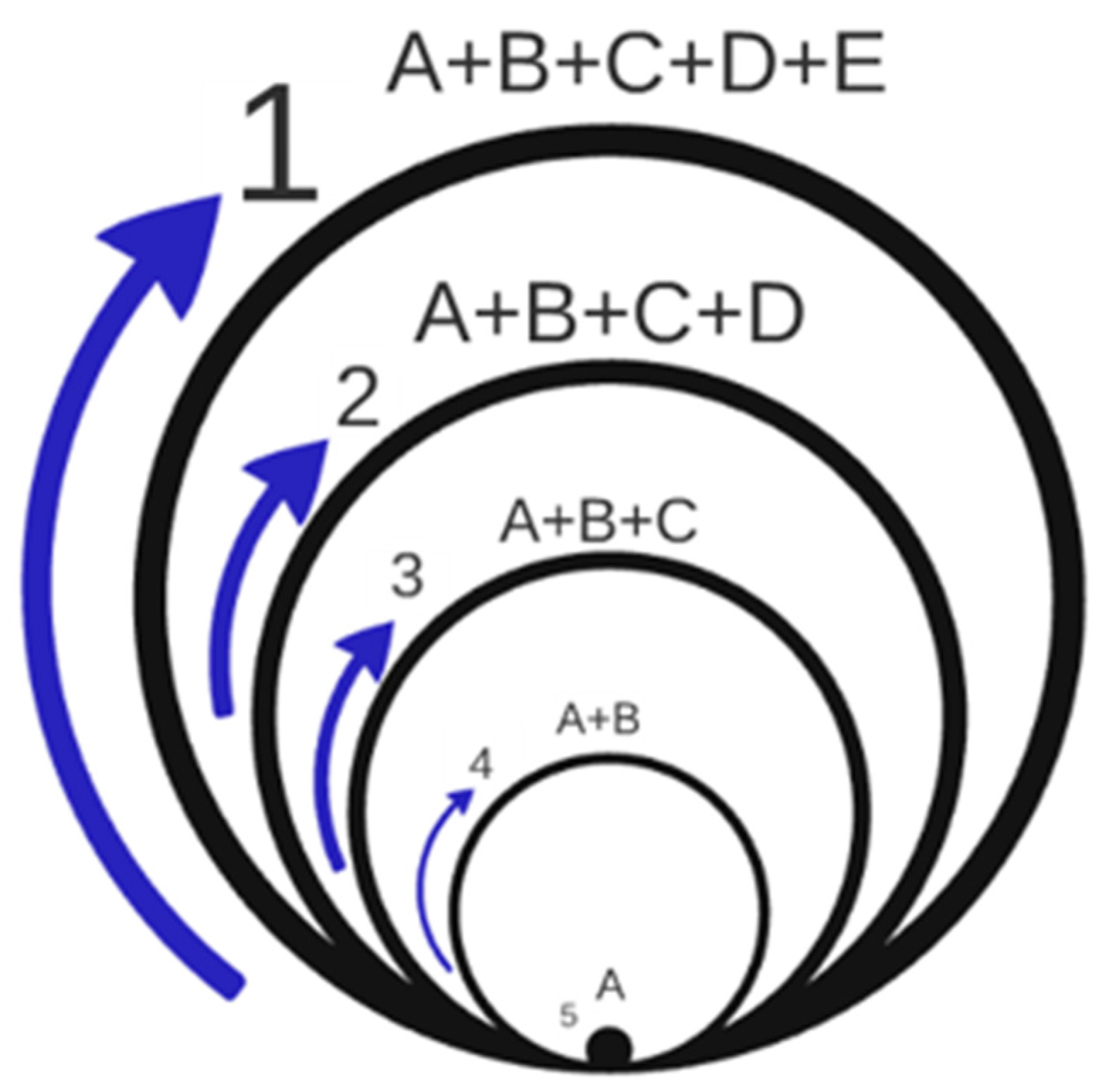


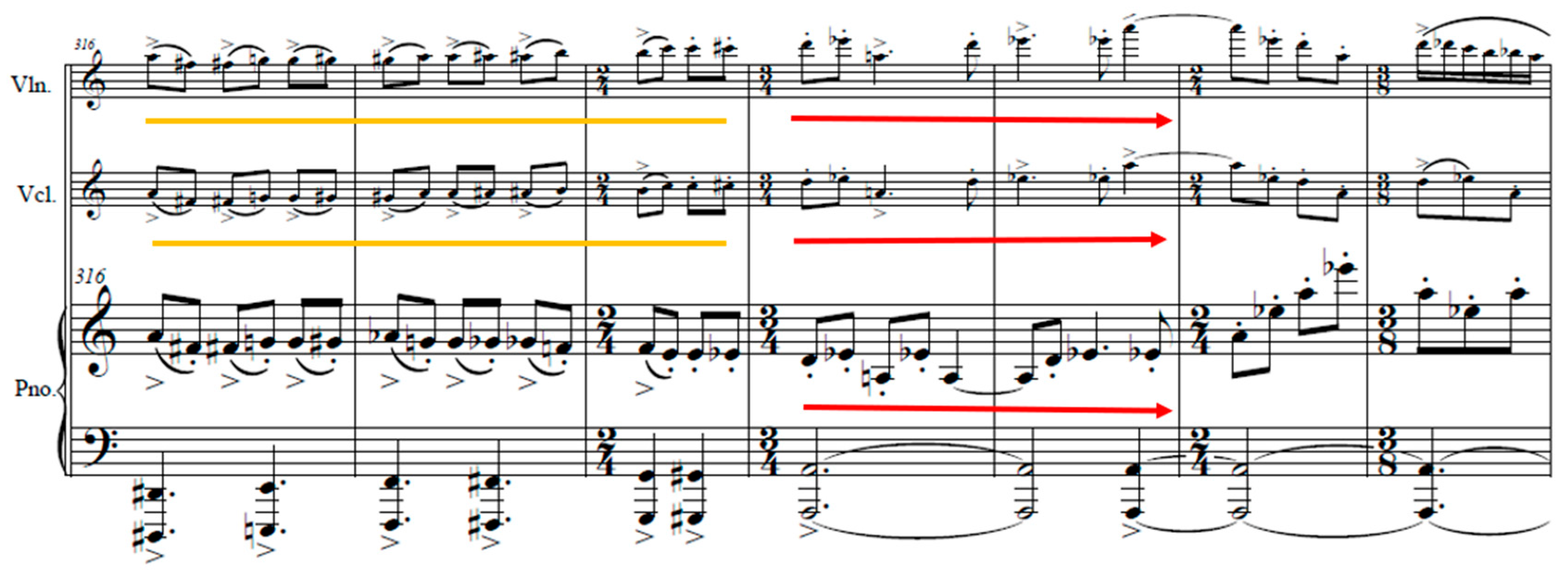
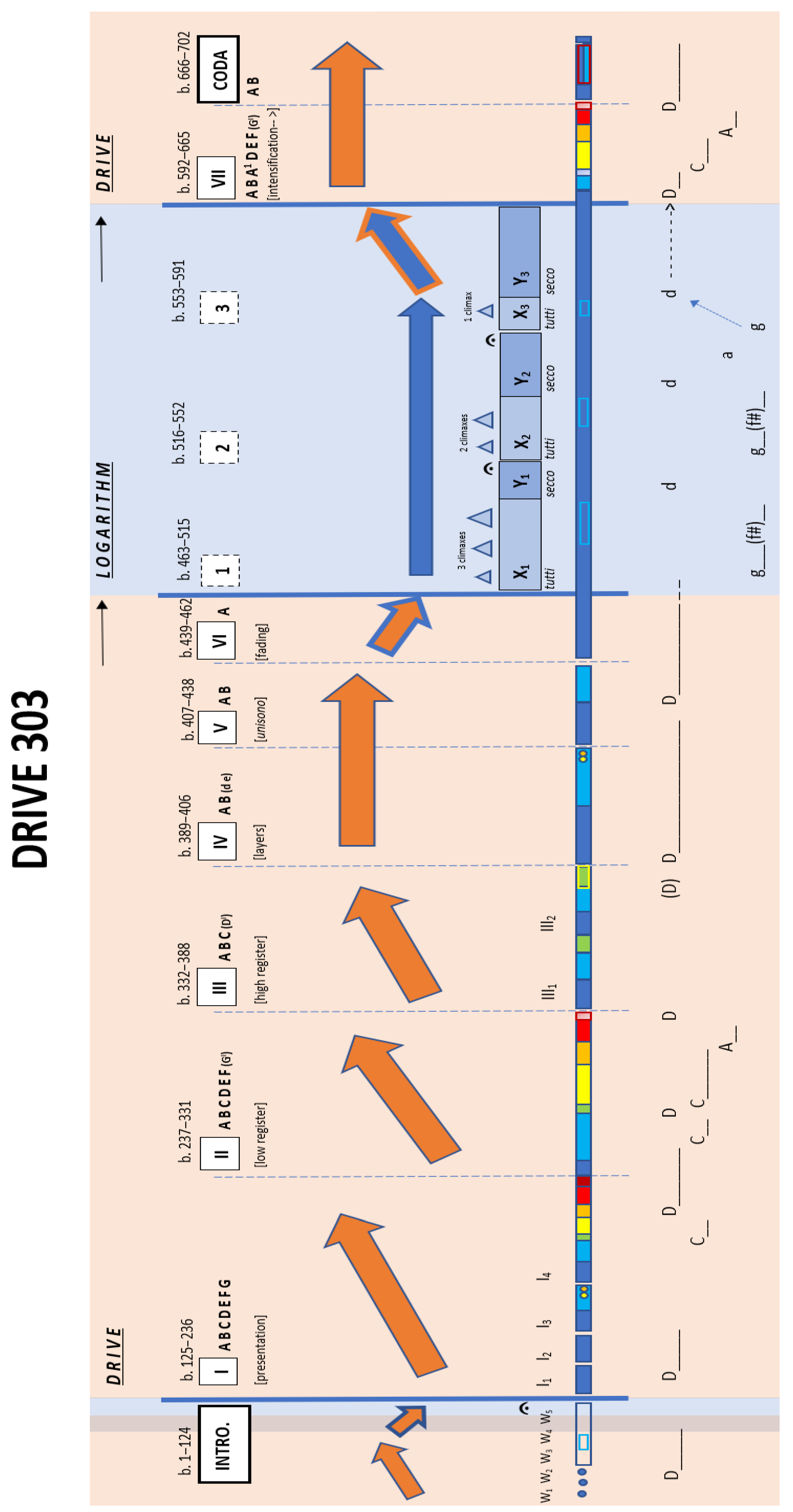
Disclaimer/Publisher’s Note: The statements, opinions and data contained in all publications are solely those of the individual author(s) and contributor(s) and not of MDPI and/or the editor(s). MDPI and/or the editor(s) disclaim responsibility for any injury to people or property resulting from any ideas, methods, instructions or products referred to in the content. |
© 2025 by the author. Licensee MDPI, Basel, Switzerland. This article is an open access article distributed under the terms and conditions of the Creative Commons Attribution (CC BY) license (https://creativecommons.org/licenses/by/4.0/).
Share and Cite
Kusiak, P. Expressive Circles—Original Concept Regarding the Structural and Dramaturgical Aspects of the Musical Composition in the Piece EXPRESSIVE CIRCLES—Three Pieces for Piano Trio: Composer’s Self-Reflection. Arts 2025, 14, 98. https://doi.org/10.3390/arts14040098
Kusiak P. Expressive Circles—Original Concept Regarding the Structural and Dramaturgical Aspects of the Musical Composition in the Piece EXPRESSIVE CIRCLES—Three Pieces for Piano Trio: Composer’s Self-Reflection. Arts. 2025; 14(4):98. https://doi.org/10.3390/arts14040098
Chicago/Turabian StyleKusiak, Patryk. 2025. "Expressive Circles—Original Concept Regarding the Structural and Dramaturgical Aspects of the Musical Composition in the Piece EXPRESSIVE CIRCLES—Three Pieces for Piano Trio: Composer’s Self-Reflection" Arts 14, no. 4: 98. https://doi.org/10.3390/arts14040098
APA StyleKusiak, P. (2025). Expressive Circles—Original Concept Regarding the Structural and Dramaturgical Aspects of the Musical Composition in the Piece EXPRESSIVE CIRCLES—Three Pieces for Piano Trio: Composer’s Self-Reflection. Arts, 14(4), 98. https://doi.org/10.3390/arts14040098





